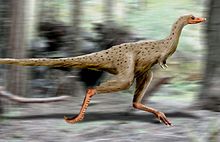| Linhenykus Temporal range: Late Cretaceous, 75–71 Ma PreꞒ Ꞓ O S D C P T J K Pg N ↓ | |
|---|---|

| |
| Skeletal restoration, showing known parts in white | |
| Scientific classification | |
| Domain: | Eukaryota |
| Kingdom: | Animalia |
| Phylum: | Chordata |
| Clade: | Dinosauria |
| Clade: | Saurischia |
| Clade: | Theropoda |
| Family: | †Alvarezsauridae |
| Tribe: | †Mononykini |
| Genus: | †Linhenykus Xu et al., 2011 |
| Species: | †L. monodactylus |
| Binomial name | |
| †Linhenykus monodactylus Xu et al., 2011 | |
Linhenykus is an extinct genus of alvarezsaurid theropod dinosaur from the Late Cretaceous of Inner Mongolia, China. It is the most basal known member of the Parvicursorinae. The genus gets its name from Linhe, a city near the site where the fossil was first found and Greek nykus, "claw". The specific name is derived from Greek monos, "single", and daktylos, "finger", a reference to the fact that it is the only known non-avian dinosaur to have had but a single digit.
Description


Linhenykus was a small dinosaur, measuring 50 cm (1.6 ft) long and weighing 500 g (18 oz). Its femur length is 7 centimetres (2.8 in).
Alvarezsauroids are known for their short forelimbs, each with a single greatly enlarged second digit. Although alvarezsaurids were once thought to have only a single digit on each forelimb, more recent evidence has shown that most species have reduced third and fourth digits. Linhenykus is the first known alvarezsaurid to have only a single, second digit. Although a reduced third metacarpal is present, the phalanges or finger bones of the third digit was entirely lost. The fourth metacarpal is not preserved in the Linhenykus holotype, but given that digit III is a reduced structure lacking phalanges, it is probable that this metacarpal is entirely absent in Linhenykus. Despite having the most reduced digits of any alvarezsauroid, Linhenykus was shown by cladistic analysis to have been a basal form as is indicated by the fact that its enlarged digit is not as large or robust as with more advanced forms.
Some scientists have suggested Linhenykus, like other alvarezsaurids, was insectivorous, using its claws to dig into ant and termite nests, similar to modern anteaters.
Discovery
The fossil of Linhenykus was collected by Jonah N. Choiniere and Michael Pittman from the Late Cretaceous Wulansuhai Formation of Nei Mongol (Inner Mongolia), China. Biostratigraphic and lithographic correlations suggest that the formation dates to the Campanian and Maastrichtian stages, 75-71 Ma. Linhenykus is currently known from a partial skeleton, holotype IVPP V17608, including cervical, dorsal, sacral and caudal vertebrae, forelimb, hindlimbs, and pelvis, and a referred complete pes (anatomy). The genus was first described and named in the Proceedings of the National Academy of Sciences by Xu Xing, Corwin Sullivan, Pittman, Choiniere, David Hone, Paul Upchurch, Tan Qingwei, Xiao Dong, Lin Tan and Han Fenglu in 2011. In 2013, an osteological monograph of the genus was published which included a quantitative analysis of alvarezsauroid biogeography. The latter found statistically significant biogeographic reconstructions suggesting a dominant role for sympatric (or ‘within area’) events, combined with a mix of vicariance, dispersal and regional extinction.
It has been suggested that Linhenykus may be a junior synonym of Parvicursor, but this interpretation was rejected by the original authors and has not been adopted in subsequent research on alvarezsauroids.
Classification
The cladogram below shows the phylogenetic position among alvarezsaurids following Makovicky, Apesteguía and Gianechini (2012).
| Alvarezsauridae |
| ||||||||||||||||||||||||||||||||||||||||||
References
- Paul, G. S. (2016). The Princeton Field Guide to Dinosaurs (2nd ed.). Princeton, New Jersey: Princeton University Press. p. 136. ISBN 9780691167664.
- ^ Xu, Xing; Sullivan, Corwin; Pittman, Michael; Choiniere, Jonah N.; Hone, David W.E.; Upchurch, Paul; Tan, Qingwei; Xiao, Dong; Lin, Tan; Han Fenglu (2011). "A monodactyl nonavian dinosaur and the complex evolution of the alvarezsauroid hand". Proceedings of the National Academy of Sciences of the United States of America. 108 (6): 2338–2342. Bibcode:2011PNAS..108.2338X. doi:10.1073/pnas.1011052108. PMC 3038769. PMID 21262806.
- Suzuki, S; Chiappe, L.; Dyke, G.; Watabe, M.; Barsbold, R.; Tsogtbaatar, K.; et al. (2002). "A new specimen of Shuvuuia deserti Chiappe et al., 1998, from the Mongolian Late Cretaceous with a discussion of the relationships of alvarezsaurids to other theropod dinosaurs". Contributions in Science. 494: 1–18. doi:10.5962/p.226791. S2CID 135344028.
- "Linhenykus: A weird, one-fingered dinosaur". Smithsonianmag.com. Retrieved 26 May 2022.
- Hone, David W.E.; Choiniere, Jonah N.; Tan, Qingwei; Xu, Xing (2013). "An articulated pes from a small parvicursorine alvarezsauroid dinosaur from Inner Mongolia, China". Acta Palaeontologica Polonica. 58 (3): 453–458. doi:10.4202/app.2011.0127.
- Xu, X.; et al. (2011). "Osteology of the alvarezsauroid Linhenykus monodactylus from the Upper Cretaceous Wulansuhai Formation of Inner Mongolia, China, and comments on alvarezsauroid biogeography". Acta Palaeontologica Polonica. doi:10.4202/app.2011.0083. hdl:10722/183730.
- Dyke, G. J.; Naish, D. (2011). "What about European alvarezsauroids?". Proceedings of the National Academy of Sciences of the United States of America. 108 (22): E147. Bibcode:2011PNAS..108E.147D. doi:10.1073/pnas.1101602108. PMC 3107280. PMID 21540333.
- Xu, X.; et al. (2011). "Reply to Dyke and Naish: European alvarezsauroids do not change the picture". Proceedings of the National Academy of Sciences of the United States of America. 108 (22): E148. Bibcode:2011PNAS..108E.148X. doi:10.1073/pnas.1104155108. PMC 3107297.
- ^ Makovicky, P. J.; Apesteguía, S. N.; Gianechini, F. A. (2012). "A new coelurosaurian theropod from the La Buitrera fossil locality of Río Negro, Argentina". Fieldiana Life and Earth Sciences. 5: 90–98. doi:10.3158/2158-5520-5.1.90. S2CID 129758444.
| Taxon identifiers | |
|---|---|
| Linhenykus | |









